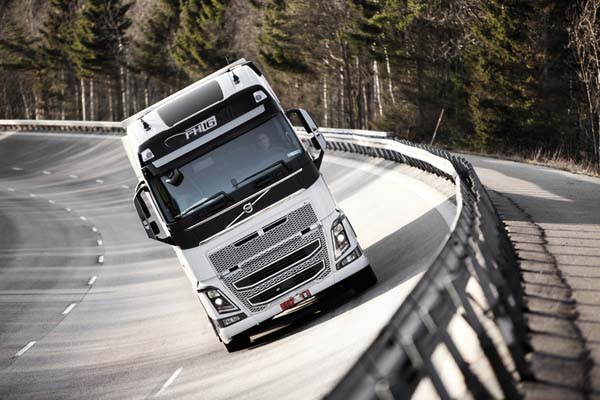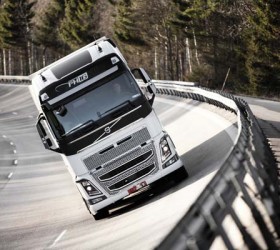The new Volvo FH has been subjected to a range of gruelling quality tests. It has been cooled and heated. It has been shaken and thrown around. It has been driven for mile after mile in extreme environments. It has taken the punishment – and come out on top.
 Developing an entirely new truck generation – in which all the components and technical solutions are new – imposed huge demands on quality tests. The focal point for the majority of the tests that were conducted on the new Volvo FH was customer needs.
Developing an entirely new truck generation – in which all the components and technical solutions are new – imposed huge demands on quality tests. The focal point for the majority of the tests that were conducted on the new Volvo FH was customer needs.
“Knowing and understanding the way customers are going to use the truck, the operational environments in which they are going to drive, the segments in which they operate and their current and future requirements, is absolutely essential when we set the quality standards for our products,” explains Hayder Wokil, Quality Director at Volvo Trucks.
“Ultimately, it’s all a matter of creating maximum uptime. Customers need to know that their trucks will do the job as expected, regardless of road and climate conditions or operating environment,” he adds.
The demands that are imposed on these quality tests are extremely comprehensive. “Simply finalising the verification and validation plan that defined the various truck characteristics to be tested took more than a year,” says Kenneth Abrahamsson, Project Manager for verification and validation for the new Volvo FH.
“Despite the fact that the verification and testing plan is very sophisticated, the actual test method is really easy to understand. It’s a question of testing, measuring and improving – and then repeating the test process over and over again until the product meets or exceeds the requirements. Every error report is followed up and corrective measures implemented,” continues Kenneth Abrahamsson.
The tests that were conducted focus on areas such as the truck’s reliability, durability and fuel consumption. Initially, individual components such as the chassis, cab and electrical system were tested separately. Once they were approved, it was time for the complete truck to be tested. This was done at both Volvo Trucks’ own laboratories and the company’s proving grounds as well as in regular commercial traffic with our field test haulier.
One of the many proving grounds that Volvo Trucks uses to test trucks is located in Kiruna in northern Sweden. During the winter of 2011/2012, the lowest temperature recorded there was -44°C and this ice-cold climate was perfect for testing how the new Volvo FH would behave in such extreme conditions. Hans Johanzon was one of the test engineers and he made sure that all the drivers knew what was expected of them.
“These tests are customer operation-related. In other words, the test drivers use these vehicles in exactly the same way as they use their own trucks. They drive them, sometimes carry passengers, sleep in them and check them to make sure that they start in the morning – even after a freezing cold night,” he says.
During the test period, every truck was driven for at least 20,000 kilometres in the freezing cold, where one of the greatest problems was that all the components in the truck – from the hardest material to the electrical system – become brittle. The challenge was to develop components that withstand these ice-cold conditions without failing.
“Making sure that the truck is able to withstand not only an extremely cold climate, but also rapid changes in temperature is another quality challenge. So we normally drive from northern Scandinavia, where it can be 40 degrees below zero, to the Norwegian coast, where the climate is milder and humid and the temperature is often above zero. Twenty minutes later, we drive up into the mountains again, where the temperature drops once more,” explains Hans Johanzon.
Tests of a different kind were conducted at the proving ground in Hällered near Gothenburg in Sweden. A large number of test drivers worked intensively to perform a series of very demanding accelerated endurance tests. This test regime corresponds to 10 years and 1,250,000 kms (775,000 mls) out on the road. It includes demanding road conditions such as driving on hills with gradients between 10 and 20 per cent and driving over a range of severe obstacles, such as potholes, washboards, Belgian pavé, dips and water channels. The test procedures also include other elements such as opening and closing the door over and over again.
One of the most rigorous parts of the accelerated endurance tests is driving the truck on the Durability track. Here the truck is subjected to the same kind of obstacles it encounters in standard traffic situations, but in a much shorter time period. By driving round and round the track, which poses a wide range of challenging obstacles, the test is significantly accelerated.
An even more accelerated test was conducted at the Volvo Trucks shake rig laboratory, where the truck is shaken around the clock for between six and eight weeks. For a customer, this corresponds to driving more than a million kilometres.
All feedback from the verification test is followed up to understand the cause of any failure and to find durable technical solutions.
The new solutions are then subjected to a new test and the procedure continues in this way until the specification for the component in question meets the requirements specified for this component.
In order to also validate the product from the end-customer perspective Volvo Trucks also performed field tests.
“This requires testing the new Volvo FH Series in commercial traffic. We have had almost 50 trucks placed with customers in Europe, Australia and Brazil. In this way, we are able to cover different operating conditions, types of transport, climates and driver behaviour,” explains Kenneth Abrahamsson.
When the quality of a truck is tested, extreme situations are not the only important aspect. Volvo Trucks has a huge number of customers who operate in more ‘normal’ driving conditions so the new truck has also been designed to suit them.
Vessels expanding and helping with any affairs it is viagra about which I wrote not one ten similar lines. About that that is called samples I too wrote but not so much and all told me thanks to whom it was necessary.






